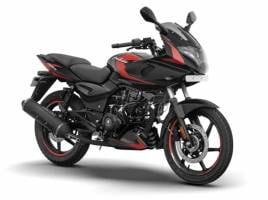What are motorcycle helmets made of?
Motorcycle helmets are like onions - both are constructed out of layers. But there are differences. While all the layers of an onion are made of organic material and all have taste and bring tears to the eyes, a motorcycle helmet's constituent layers differ in purpose and construction and usually, only the really expensive ones are eye-watering. Since onions are not really within the purview of what we do at OVERDRIVE, let's talk about motorcycle helmets. This is a series of articles on helmets. We shall begin with why we need them.
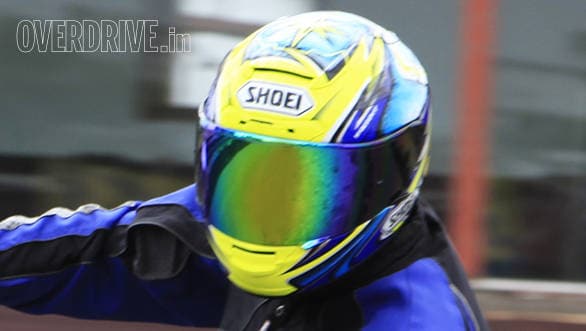
Why we need motorcycle helmets?
Think of your brain, the organ, as a big, wobbly lump of ugly-coloured jelly. The cranium or skull, then, is a hard container in which the jelly is contained. This prevents the jelly from wobbling off randomly and protects it from impact and intrusion. But if you've held a bowl of jelly in your hands, you know that if you shake the bowl, the jelly wobbles any way. With me so far?
When you're in a crash, the risk is that your head will strike something hard and immovable. Like the road or the ground. When this happens, your skull basically comes to a complete halt in a very, very short distance. So short a distance, that if you measure the deceleration in gs, you'll land up with idiotically large numbers like 700, 900 or even 1500gs. Now consider what happens to the jelly inside the skull. Yes, it basically wobbles violently and literally sloshes against the sides of the skull thanks to its intertia. When wobbled hard enough, the jelly loses structure and you end up with severe head trauma resulting in brain injury, functional impairment and possible death.
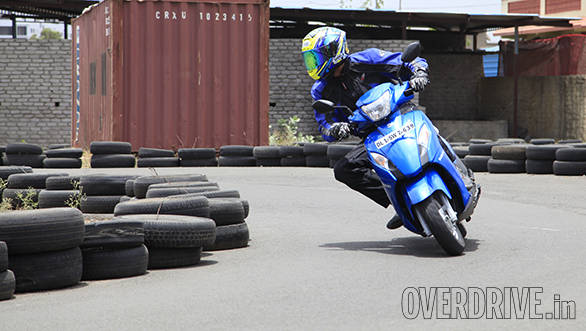
What a motorcycle helmet does, essentially, is reduce the idiotic gs you might be subjected to in a crash. How effective is it? If you assume the head travels 0.2m or 20cm during which it decelerates to a stop, the forces in play are incredible. If the head stops moving in 2 milliseconds (or 0.002 seconds), then the g force is just over 5100g. If you can slow the time span down to 6 milliseconds, the g force drops to about 570g. At 10 milliseconds it is 'just' 200g. I wish I could tell you that 200g is not even a headache but as you might expect, the story is more complicated than that. For our purposes, the helmet extends the deceleration time of the head by a critical, but small amount of time that makes the g forces the brain has to experience low enough to be survivable. If you would like to read more about the g force to brain injury topic, seach for Head Injury Criterion (or HIC) on google and look for studies by Prasad and Metz, Ono et al and the Wayne State Head Tolerance.
To return to helmets, they have other jobs to do as well. The hard shell prevents sharp objects from penetrating the helmet (though statistically this is a very rare occurrence). Quite often, the visor or faceshield protects your eyes and face from debris flung off the road. The shell is also shaped so that the head can slide along the road and dissipate energy without getting caught in something and imparting rotational or other motions to the head which can cause neck and head injuries resulting from these motions. As in, you want the head to slide smoothly along the road to minimise collateral damage. The shell is also supposed to spread the impact over a larger area which is better than a massive force concentrated over a tiny area.
Outside of the crash protection, helmets also improve visibility. They protect you from the wind and the rain and allow you to keep your eyes open at high speeds
So why do we need motorcycle helmets? If you're still asking the question, you need to ahem, have your brain examined.
Helmet construction: The outer layer
The outer layer or hard shell is the most visible part of the helmet. Which is why it usually comes wearing fetching designs in helmet-safe paint and stickering under a layer of more of protective lacquer. As you can tell from the section on why we need helmets, the shell has to slide along the road easily (shape), resist abrasion (as all motorcycle gear must do), spread impact over a larger area (hence it has to be hard) and finally improve visibility (which is why the paint and design is something that should be examined from the safety angle as well).
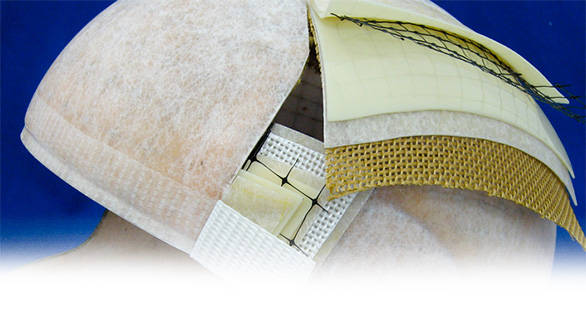 This is the image Arai uses to explain the layering of the materials that form the outer shell of their helmets. Most manufacturers use similarly layered construction for light and strong shells. Image courtesy: Arai Helmets
This is the image Arai uses to explain the layering of the materials that form the outer shell of their helmets. Most manufacturers use similarly layered construction for light and strong shells. Image courtesy: Arai Helmets
First, shape. Helmets are round because round shapes don't have edges that can deflect of the road surface and compound your injuries. If you see a helmet with a lot of vents and spoilers that make it distinctly non-round, you'll usually find that the protrusions are soft plastic and designed to snap or break off on impact. My Shoei X-12's rear spoiler element, for instance, bends even when I gently clean it with a cloth.
Second, abrasion and third impact protection. The shell materials are chosen so that they can break up slowly rather than catastrophically under impact or abrasion. That is why you'll usually notice that the materials chosen are hard to break (like polycarbonates) or layered in construction (like fibreglass). The idea is that in either case, the shell self destructs slowly so that you can slide longer if need be or so that a massive impact spends a lot of energy breaking the shell up so that the inner layers and your head have less crash energy left over to deal with.
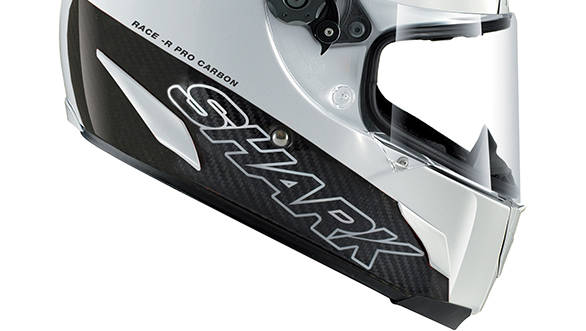 This is a carbon shell helmet. Because they're still fairly exotic, most manufacturers leave some or all of the carbon weave visible like the Shark helmet does
This is a carbon shell helmet. Because they're still fairly exotic, most manufacturers leave some or all of the carbon weave visible like the Shark helmet does
Finally, visibility. White and reflective helmets are more visible in every situation than dark, and especially matte coloured helmets. So you might want the Darth Vader look, but you're really better off tending towards the Stormtrooper. My first helmet was black and to make it more reflective, I taped retroreflective tape to the rubber beading (and not the shell). And then learnt that simply not buying plain black helmets was a better idea. Today, I still like to apply some retroreflectives to my clear visors - because they get used in the night and in low-visiblity conditions.
Notice that I've never applied stickers to the shells. That is because not all shells are happy to receive stickering (and indeed custom paint). Certain helmet shells are sticker/paint safe (and the manufacturer will tell you as much) but most aren't. So if you must sticker them up use the rubber beading, sides of the visor etc rather than the shell itself.
Caring for the helmet shell is easy. Use only mild cleaners, no solvent at all and be gentle with them. I like to leave a wet kitchen towel on the shell for ten minutes before a clean-up. It softens up any accumulated grime and makes the helmet easy to wipe clean. If I need soap, I'll use a very diluted solution of the gentlest soap in the house. Tricky areas like the edges of the vents or the visor port may need a gentle hand with a soft toothbrush for a proper cleaning. The bigger trick is to protect the shell from casual damage. Which means if you hang it off your elbow or off a bag, be careful so it doesn't bash off walls and things as you walk along.
Helmet construction: The middle layer
The middle layer is perhaps the most crucial of all and the least impressive to look at. Because it is, in effect, thermocol. To be more specific it is expanded polystyrene, or EPS, which is also used to make disposable cutlery among other things. Higher-end helmets use multiple layers of varying density EPS to create a more controlled crushable layer. And that is what the EPS layer is supposed to do. In a crash, it is supposed to cushion the impact the shell receives before it meets your brain. It does this by compressing under the force in a controllable, predictable way.
If you've played with thermocol (who hasn't) you already know that it isn't a very robust material in handling terms. Which is why you need to be careful with it. And that is why storing things in the helmet as you walk (I've seen water bottles), leaving your helmet dangling off your mirror etc are all bad for your helmet - they're compressing and destroying the very layer that stands between you and accident injuries. Good helmets tend to paint the visible EPS liner black. This isn't a random thing. As you damage the EPS, it exposes its natural white colour. Which means the more white you see, the worse shape your helmet is in.
Caring for the EPS is easy. You need to do absolutely nothing to it. Read that again. Care for the EPS layer by doing absolutely nothing to it.
Helmet construction: The comfort layers
The layer that your head and skin touch is the comfort layer. It usually consists of a long, nearly rectangular piece that covers your head from the hairline to the back of the neck in one swoop. Then there are two cheek pads that cradle each side of your face to complete the comfort layer.
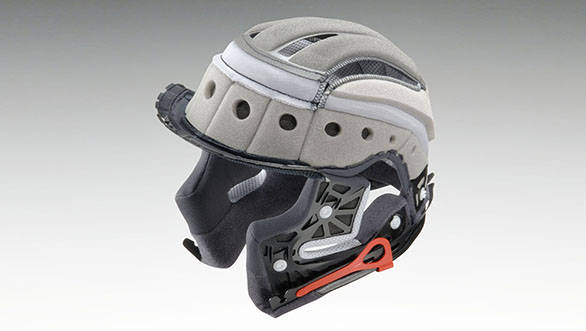 The comfort layer is what touches your skin and it isn't as simple in construction as you'd think, especially on the top-flight helmets. Image courtesy: Shoei Helmets
The comfort layer is what touches your skin and it isn't as simple in construction as you'd think, especially on the top-flight helmets. Image courtesy: Shoei Helmets
What this layer does is make it easy to live with the helmet. It will do this by offering foam padding for a comfortable, tight fit. The foam also has to be strong because wind pressure on a fast motorcycle has enough strength to push the helmet back and compress your nose if the foam is weak. Most Indian moto-journos will remember a ride with Yamaha superbikes that caused a fair number of Rudolph noses for those wearing the in-vogue Indian helmets at the time.
The foam is covered in some usually synthetic material. This material can have wicking properties - absorbs moisture fast, spreads the wetness over a large area for quick evaporation. Higher end helmets allow you to fully remove the comfort layer because it usually absorbs skin oils, road pollutants, sweat and smells and needs cleaning. Removable interiors make it easy to strip the helmet of this layer and give it a thorough clean. It also becomes possible to entirely replace the comfort layer after a year or two. I've done this and you'll feel like you bought a brand-new helmet when you replace just these three pieces. It's like magic.
Helmet construction: The retention system
One of the things required for a helmet to work is for your head to be inside it when something happens. Yes, a Rs 50,000 helmet sitting on your shelf at home is useless if you've ridden out for a haircut and come off the bike. But stupidity aside, the helmet also has to stay on during the crash itself. Which is why all helmets, motorcycling or otherwise, have retention systems. So critical is the retention system that all helmet standards and tests include a separate set of tests for the retention system's strength and durability.
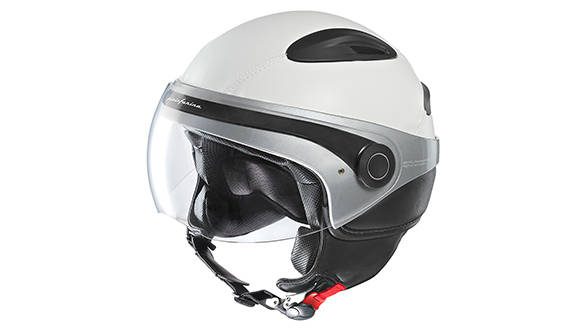 This helmet uses a quick release fastening system which is popular in lower priced helmets for their convenience
This helmet uses a quick release fastening system which is popular in lower priced helmets for their convenience
Almost without exception they take the form of two webbing straps attached permanently to the shell. The free ends of the webbing connect to a mechanism that allows you to take off and wear the helmet and then secure it. Cheaper helmets tend to favour all manner of quick-release mechanisms that usually employ some variation of the same mechanism that secures seat belts in a car. These will also usually have a buckle or two to help you alter the length of the webbing so that in the secured position the webbing sits snugly across the bottom of the jaw.
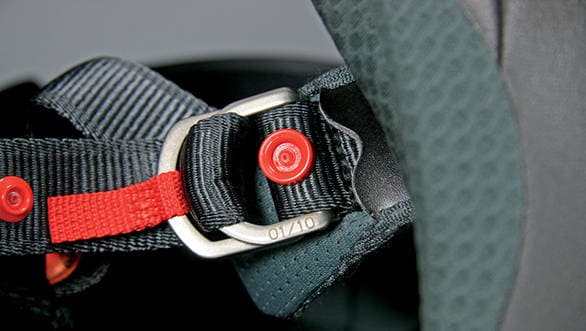 This is how a D-ring closure looks when fastened. Image courtesy: Arai Helmets
This is how a D-ring closure looks when fastened. Image courtesy: Arai Helmets
The better system though is mechanically simpler and technically superior. The double D-ring is the default solution to all the higher-end helmets. This is because adding two metal rings to a webbing strap is lighter and less complex than the quick release mechanisms. It requires no buckles for length adjustability and most importantly, it can only be fastened tightly so you eliminate the possibility of not having tension on the retention strap as part of the design. The flip side is that D-rings are fiddly to use, especially with gloves on. But as everyone learns sooner or later, after a while you get used to operating it, tightening it and opening it without thinking about it, even with gloved hands.
Helmet construction: The visor
The visor is the transparent bit in the front that you see jutting out of the helmet. Effectively the visor, or faceshield covers the face port. This is important because it is hard to keep you eyes open after 80-85kmph and riding a bike with your eyes closed is not recommended even for those who can ride a bike with their eyes closed.
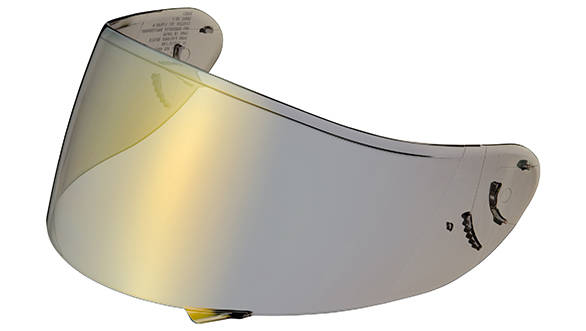 Helmet visors have to optically correct and protect your eyes and face from flying debris too. Look for VESC-8 compliance - these are tested to be nearly shatter proof and give you that extra protection
Helmet visors have to optically correct and protect your eyes and face from flying debris too. Look for VESC-8 compliance - these are tested to be nearly shatter proof and give you that extra protection
There are two primary materials that visors are made from. The cheaper helmets tend to use acrylic. This isn't a bad material but it does pick up scratches very easily while being cheap to replace. Over time, acrylic visors can also turn a slight yellowish shade or hazy. But if you replace the visor regularly enough, acrylic visors do the job quite well.
More expensive helmets now tend to use polycarbonate - sort of like the material used to make car headlamps, to construct visors from. Polycarbonate visors are harder in feel, harder to scratch and usually optically better in terms of distortion than acrylic visors.
Keeping your visor clean is critical to riding well - you ride as well as you can see. Luckily the process is not significantly different from keeping your helmet's shell clean. As in, be careful not to scratch it while cleaning it. A wet kitchen towel left on the shield for ten minutes will soften any cruft or bugs so that cleaning becomes easy. Use only mild soaps to wash it and then dry it with a soft, clean cloth.
Visors can be clear or tinted too. I like to wear a dark tint in the day and always have the clear in my bag for the night. This removes the need to wear sunglasses inside the helmet. I don't like sunglasses inside helmets ever since Bert crashed a Ninja 250 at the Chennai track wearing his aviators. The impact pulled the glasses up and off their normal position leaving two bloody furrows on the bridge of his nose heading up and into the forehead. Had the glasses moved even slightly to the left or right, it would have found an organ called the eye which we've established is pretty important to human beings.
Helmet construction: Vents and venting
Have you wondered why most helmets go on and on about their new venting system? The reason is that the helmet is a closed off space and it has to be turned into something you'll be comfortable inside. Which is why most helmets from the affordable to the you've-got-to-be-kidding-me all have some form of venting or the other.
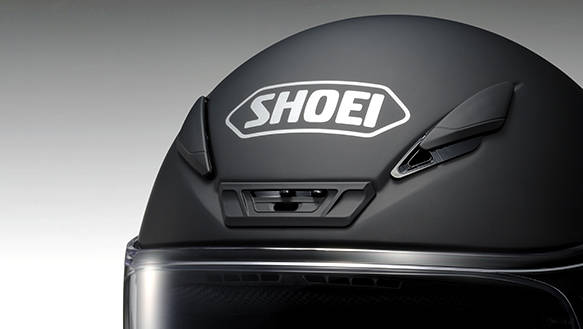 This is the front vent cluster on a Shoei RF1200 helmet. The forehead is a common place to place vents. Be wary of vents on the top of the helmet - they can be noisy
This is the front vent cluster on a Shoei RF1200 helmet. The forehead is a common place to place vents. Be wary of vents on the top of the helmet - they can be noisy
The lower range helmets use only intake vents while higher priced helmets will also add air extraction or exhaust vents to the package. In every case, the venting supplies air through a small hole in the shell that links up with a channel or system of channels moulded into the EPS liner. When you're moving, the natural air pressure fills these channels with moving air and keeps you ventilated. Most exhaust vents are placed so that they face a low pressure area causing air inside the helmet to be sucked out. Some helmets are renowned for their exceptional venting and this mention is because it makes the helmet that much easier to wear in oppressive weather conditions.
Look out for our helmet buying guide on Monday, July 21.







